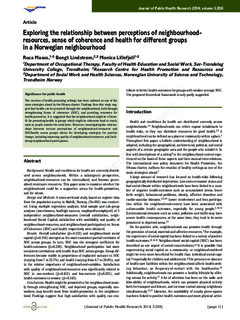| dc.contributor.author | Maass, Ruca Elisa Katrin | |
| dc.contributor.author | Lindstrøm, Bengt | |
| dc.contributor.author | Lillefjell, Monica | |
| dc.date.accessioned | 2019-11-04T08:43:24Z | |
| dc.date.available | 2019-11-04T08:43:24Z | |
| dc.date.created | 2014-01-20T10:03:45Z | |
| dc.date.issued | 2014 | |
| dc.identifier.citation | Journal of Public Health Research. 2014, 3 (1), 11-21. | nb_NO |
| dc.identifier.issn | 2279-9028 | |
| dc.identifier.uri | http://hdl.handle.net/11250/2626275 | |
| dc.description.abstract | Background. Health and conditions for health are unevenly distributed across neighbourhoods. Within a salutogenic perspective, neighbourhood-resources can be internalised, and become generalised resistance resources. This paper aims to examine whether the neighbourhood could be a supportive arena for health-promotion, and for whom.
Design and Methods. A cross-sectional study, based on register data from the population-survey in Malvik, Norway, (N=865) was conducted. Using multiple regression analysis, total sample and sub-group analyses (men/women, low/high earners, employed/unemployed) of 5 independent neighbourhood-measures (overall satisfaction, neighbourhood Social Capital, satisfaction with availability and quality of neighbourhood-resources, and neighbourhood participation) on Sense of Coherence (SOC) and health respectively were obtained.
Results. Overall satisfaction (β=0.153) and neighbourhood social capital (β=0.134) emerged as the most consistent partial correlates of SOC across groups. In turn, SOC was the strongest coefficient for health-outcomes (β=0.238). Neighbourhood participation had more consistent correlations with health than SOC across groups. Group-differences became visible in proportions of explained variance in SOC (varying from 7 to 23.7%) and health (varying from 6.7 to 20.6%), and in the relative importance of neighbourhood-variables. Satisfaction with quality of neighbourhood-resources was significantly related to SOC in non-workers (β=0.451) and low-earners (β=0.261), and health-outcomes in women (β=0.143).
Conclusions. Health might be promoted in the neighbourhood mainly through strengthening SOC, and deprived groups, especially non-workers, may benefit most from health-promotion in the neighbourhood. Findings suggest that high satisfaction with quality can conribute to better health-outcomes for groups with weaker average SOC. The proposed theoretical framework is only partly supported. | nb_NO |
| dc.language.iso | eng | nb_NO |
| dc.publisher | Page Press | nb_NO |
| dc.rights | Navngivelse-Ikkekommersiell 4.0 Internasjonal | * |
| dc.rights.uri | http://creativecommons.org/licenses/by-nc/4.0/deed.no | * |
| dc.title | Exploring the relationship between perceptions of neighbourhood-resources, sense of coherence and health for different groups in a Norwegian neighbourhood | nb_NO |
| dc.type | Journal article | nb_NO |
| dc.type | Peer reviewed | nb_NO |
| dc.description.version | publishedVersion | nb_NO |
| dc.source.pagenumber | 11-21 | nb_NO |
| dc.source.volume | 3 | nb_NO |
| dc.source.journal | Journal of Public Health Research | nb_NO |
| dc.source.issue | 1 | nb_NO |
| dc.identifier.doi | 10.4081/jphr.2014.208 | |
| dc.identifier.cristin | 1094191 | |
| dc.description.localcode | Open Access. This work is licensed under a Creative Commons Attribution-NonCommercial 4.0 International License. | nb_NO |
| cristin.unitcode | 194,65,30,0 | |
| cristin.unitcode | 194,65,20,0 | |
| cristin.unitname | Institutt for nevromedisin og bevegelsesvitenskap | |
| cristin.unitname | Institutt for samfunnsmedisin og sykepleie | |
| cristin.ispublished | true | |
| cristin.fulltext | original | |
| cristin.qualitycode | 1 | |

